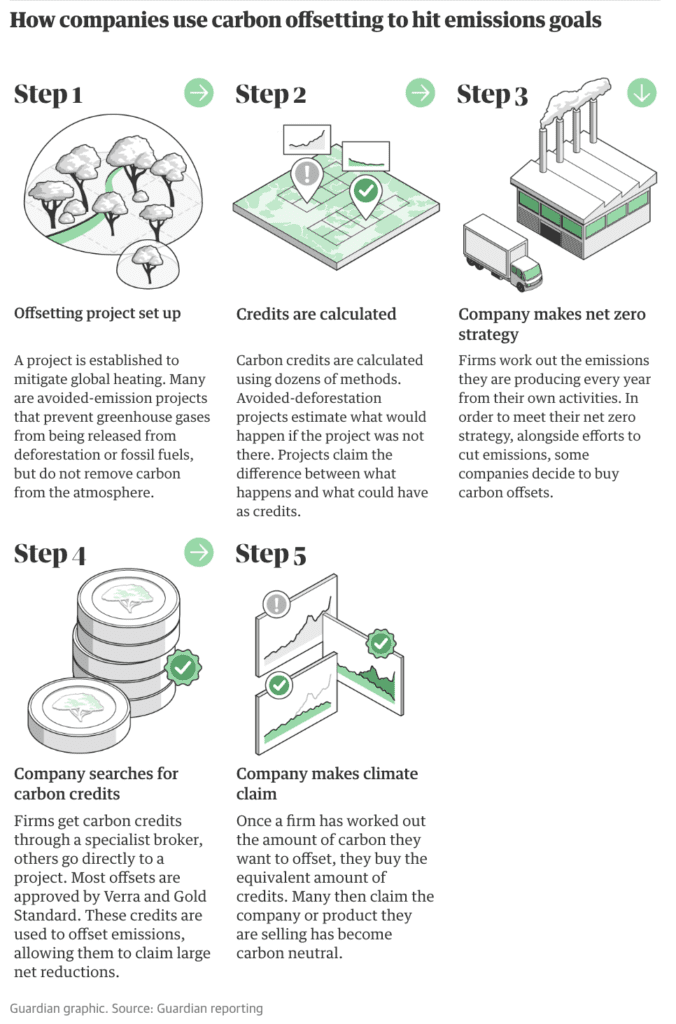Page content
CO2 neutrality journey
Like many other B Corps, we joined the Climate Collective in 2020 stating our commitment to becoming Net-Zero by 2030 – 20 years ahead of the 2050 targets set in the Paris Agreement.
Now that we had our intentions set out to the world vocally, the action would start.
Quest Impact Design Studio is a small service-led business with energy-saving policies such as green-energy facilities, electric cars, cycling incentives, virtual work policies, and low-impact offers for clients. We knew our carbon footprint would be small, and we would obtain a CO2-neutral label within a few months, if not faster. At least according to the dozens of consultancies, we reached out to.
But we’re not there yet. So why is Quest not climate-neutral?
Truth is, we’re not convinced if the current system of carbon neutrality is the right one for us.
How to become CO2 neutral
As we commonly see, commitments are exciting and sometimes well-intentioned, but a commitment to hit a target is not a guarantee of achieving the goal. A lot of the commitments and labels we see pop up are obtained through the current carbon system, one that is currently a $ 2 billion industry and, to be put plainly, is still misunderstood—as we see in the recent article by the Guardian or even on late night tv.
Though I want to make one thing clear, this is not a critique of the carbon market, but a summary of our journey navigating our commitment to do the best for the planet as a company, sometimes at a greater cost to ourselves.
For those not aware of the CO2 neutral process, the current system—or I should say the most popular system—works:
You have a consultancy (or internally) measure your CO2 footprint. The process can be different company by company; some measure through money spent, others use general data, and most measure scopes 1 and 2, ignoring the biggest factor of all: the ever-alluding scope 3 emissions.
Now, I will say there are amazing companies that push further in this measurement and implementation and we truly believe in their commit to true CO2 neutrality.
From here, depending on the company’s approach, you are taken through options for reducing your footprint as a company. Many things we have done at Quest, such as reducing travel, moving toward electric, cycling policies, etc. Some, on the other hand, do go directly to offsetting—these I recommend running away from.
Once you have calculated the estimated emissions and have done the work to reduce them, you are given options to offset, or in other words, pay for forgiveness, for the unavoidable emissions.

CO2 Offsetting projects
After interviewing and researching dozens of certified companies and CO2 projects, the most common options to offset come down to the following:
- Planting trees: though sometimes this really is only buying part of a tree or just delaying a tree being torn down, or planting a tree that was going to be planted anyway. If you are planting a tree, it will also take some time before it begins being able to capture its full capacity.
- Providing social impact: though these projects do support communities through efficient cookstoves and access to clean drinking water, they are done so in a country that produces the least amount of carbon but is most affected by the world’s largest polluters.
- Transition to green energy: similar to those mentioned prior, these projects are helping lower-income communities or countries transition to biogas or renewable energy.
As you see, though very impactful, when done correctly, these projects essentially are placing money in a different location than where the CO2 was emitted. So this whole notion that a ton of CO2 saved in one place is just as good as a ton of CO2 saved in another, especially when you’re adding in additional co-pollutants, doesn’t make sense.
As an impact-driven service provider, we push our clients to go further when working on their impact strategy and commitments. Because of this, we wanted to see what else was out there and explore if alternatives like carbon-capturing technologies, amongst others, could make a bigger difference for our planet.
So we decided to take research into our own hands and look into what innovative solutions were out there, and why they are not the ones everyone is talking about.
Innovating the carbon capture market
In 2021, we gave our team a clear assignment: if we decide to go CO2-neutral, what are the best and most impactful projects globally?
For a year, we reviewed established pathways to promising man-made solutions that have not been demonstrated at scale yet. We came out with a list of best practices, emerging trends, proposed policies, and promising projects to support as an alternative offsetting process.
We explored solutions that would transform our soil to capture more carbon, to solutions looking deep into our oceans. Though I can geek out on all the technologies we looked into, for brevity we’ll dive into our top five areas.
Using the air we breathe: though there are more in this space, the most popular now is Swiss leader, Climeworks, which removes CO₂ from the air with direct air capture technology.
Improving solid for more carbon storage: Carbo Culture disrupts the carbon route by turning biomass into biochar. They lock that carbon into a stable and solid form for over 1000 years.
Transforming our livestock: Swedish innovator, Voltagreentech, is not making another vegan protein alternative but is using seaweed to reduce methane emissions by feeding it to cows. Though Australian organization, Rumin8, has a similar take.
Saving our largest & bluest resource: Our favorite solution was discovering the developing world of blue credits. Blue credits are projects that seek to conserve and restore natural blue carbon sinks. The one that stood out for us was Seatrees, which works with communities around the world in protecting and planting mangroves, kelp forests, coral reefs, etc.
Reusing our heat: We also begin looking into more commercially-driven solutions like CleanO2, which captures carbon from commercial heating systems into products like soap through their technology unit, carbonX… Talk about cleaning our waste…
When we evaluated all these options, their scalability, additionality, permanence, and ability to act as a safeguard against climate change, we concluded that the answer has been staring straight back at us all along.
The best way to save nature is to work hard to conserve it. Duh.
Investing in climate-positive solutions
When we looked at these facts, we could only conclude that a CO2-neutral label might help our marketing, but if we’re thinking in terms of impact maximization it’s not the best option.
We interviewed multiple carbon labeling organizations and received average costs of 5,000 EUR. At this point an executive decision was to be made: do we go with the system that offers us a label through funding or invest this amount to further solutions that will make the most difference in terms of carbon emissions, even if we do not get the marketing credit?
So instead of using our financial resources for a badge that, though well intended but ill-defined, is going to beef up our marketing presence, we decided to put our money where our heart is and invest in our biodiversity.
Biodiversity Conservation
Biodiversity supports everything in nature that we need to survive: food, clean water, medicine, and shelter. But there’s more: around half of the carbon emissions produced worldwide remain in the atmosphere, while the other half is absorbed by the land and ocean. These ecosystems—and the biodiversity they contain—are natural carbon sinks, providing so-called nature-based solutions to climate change. Isn’t it great? However, human activities are degrading ecosystems worldwide, posing existential threats to biodiversity, the planet, and people.
- Forests absorb up to 11 tonnes of CO2 per hectare per year.
- Wetlands cover only 3% of the world’s land, but they store twice as much carbon as all the forests.
- Ocean habitats sequester up to 31% carbon dioxide from the atmosphere at rates up to four times higher than terrestrial forests can.
All in all, about one-third of the greenhouse gas emissions reductions needed in the next decade can be achieved by improving nature’s ability to absorb emissions. In order to accomplish that, we need to ensure the survival of species and the health and integrity of our planet’s biodiversity. By understanding threats to biodiversity, and how they play out in context, we can be best prepared to manage conservation challenges.
Based on all these insights on capturing technology, offsetting projects, and long-term commitment to the environment, we decided to launch a new organization that works on a long-term structural solution to climate change and biodiversity degradation.
Now, this does not mean we use this project as a cop-out and say our work is done. These numbers can and should be questioned because the main problem with conservation impact is reliably forecasting the future. We will not be using this as our offsetting solution, as we will not associate our carbon with that of what we conserve.
Quest will be launching this conservation project starting in the summer of 2023. Want to learn more, let’s connect further.




